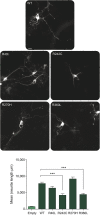TBC1D24 genotype-phenotype correlation: Epilepsies and other neurologic features
- PMID: 27281533
- PMCID: PMC4932231
- DOI: 10.1212/WNL.0000000000002807
TBC1D24 genotype-phenotype correlation: Epilepsies and other neurologic features
Abstract
Objective: To evaluate the phenotypic spectrum associated with mutations in TBC1D24.
Methods: We acquired new clinical, EEG, and neuroimaging data of 11 previously unreported and 37 published patients. TBC1D24 mutations, identified through various sequencing methods, can be found online (http://lovd.nl/TBC1D24).
Results: Forty-eight patients were included (28 men, 20 women, average age 21 years) from 30 independent families. Eighteen patients (38%) had myoclonic epilepsies. The other patients carried diagnoses of focal (25%), multifocal (2%), generalized (4%), and unclassified epilepsy (6%), and early-onset epileptic encephalopathy (25%). Most patients had drug-resistant epilepsy. We detail EEG, neuroimaging, developmental, and cognitive features, treatment responsiveness, and physical examination. In silico evaluation revealed 7 different highly conserved motifs, with the most common pathogenic mutation located in the first. Neuronal outgrowth assays showed that some TBC1D24 mutations, associated with the most severe TBC1D24-associated disorders, are not necessarily the most disruptive to this gene function.
Conclusions: TBC1D24-related epilepsy syndromes show marked phenotypic pleiotropy, with multisystem involvement and severity spectrum ranging from isolated deafness (not studied here), benign myoclonic epilepsy restricted to childhood with complete seizure control and normal intellect, to early-onset epileptic encephalopathy with severe developmental delay and early death. There is no distinct correlation with mutation type or location yet, but patterns are emerging. Given the phenotypic breadth observed, TBC1D24 mutation screening is indicated in a wide variety of epilepsies. A TBC1D24 consortium was formed to develop further research on this gene and its associated phenotypes.
© 2016 American Academy of Neurology.
Figures




References
-
- Uytterhoeven V, Kuenen S, Kasprowicz J, Miskiewicz K, Verstreken P. Loss of skywalker reveals synaptic endosomes as sorting stations for synaptic vesicle proteins. Cell 2011;145:117–132. - PubMed
MeSH terms
Substances
Grants and funding
LinkOut - more resources
Full Text Sources
Other Literature Sources
Medical
